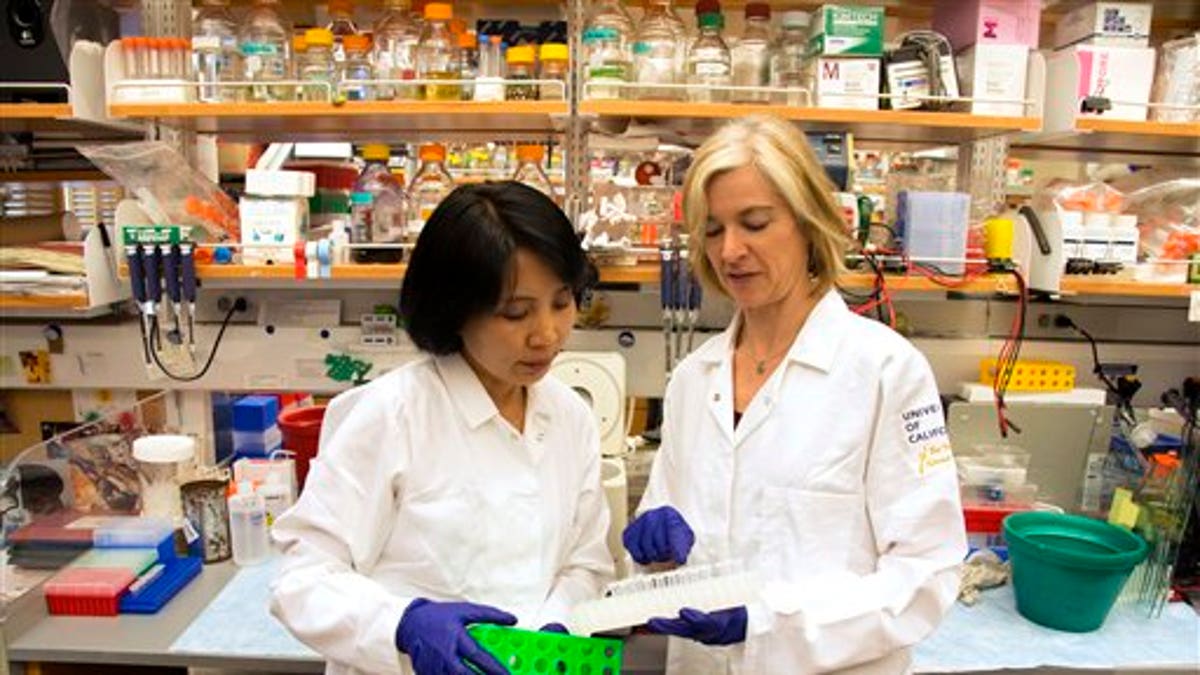
In this photo provided by UC Berkeley Public Affairs, taken June 20, 2014 Jennifer Doudna, right, and her lab manager, Kai Hong, work in her laboratory in Berkeley, Calif. (Cailey Cotner/UC Berkeley via AP)
The hottest tool in biology has scientists using words like revolutionary as they describe the long-term potential: wiping out certain mosquitoes that carry malaria, treating genetic diseases like sickle cell, preventing babies from inheriting a life-threatening disorder.
It may sound like sci-fi, but research into genome editing is booming. So is a debate about its boundaries, what's safe and what's ethical to try in the quest to fight disease.
Does the promise warrant experimenting with human embryos? Researchers in China already have, and they're poised to in Britain.
Should we change people's genes in a way that passes traits to future generations? Beyond medicine, what about the environmental effects if, say, altered mosquitoes escape before we know how to use them?
"We need to try to get the balance right," said Jennifer Doudna, a biochemist at the University of California, Berkeley. She helped develop new gene-editing technology and hears from desperate families, but urges caution in how it's eventually used in people.
The U.S. National Academies of Science, Engineering and Medicine will bring international scientists, ethicists and regulators together in December to start determining that balance. The biggest debate is whether it ever will be appropriate to alter human heredity by editing an embryo's genes.
"This isn't a conversation on a cloud," but something that families battling devastating rare diseases may want, Dr. George Daley of Boston Children's Hospital told specialists meeting this week to plan the ethics summit. "There will be a drive to move this forward."
Laboratories worldwide are embracing a technology to precisely edit genes inside living cells — turning them off or on, repairing or modifying them — like a biological version of cut-and-paste software. Researchers are building stronger immune cells, fighting muscular dystrophy in mice and growing human-like organs in pigs for possible transplant. Biotech companies have raised millions to develop therapies for sickle cell disease and other disorders.
The technique has a wonky name — CRISPR-Cas9 — and a humble beginning.
Doudna was studying how bacteria recognize and disable viral invaders, using a protein she calls "a genetic scalpel" to slice DNA. That system turned out to be programmable, she reported in 2012, letting scientists target virtually any gene in many species using a tailored CRISPR recipe.
There are older methods to edit genes, including one that led to an experimental treatment for the AIDS virus, but the CRISPR technique is faster and cheaper and allows altering of multiple genes simultaneously.
"It's transforming almost every aspect of biology right now," said National Institutes of Health genomics specialist Shawn Burgess.
CRISPR's biggest use has nothing to do with human embryos. Scientists are engineering animals with human-like disorders more easily than ever before, to learn to fix genes gone awry and test potential drugs.
Engineering rodents to harbor autism-related genes once took a year. It takes weeks with CRISPR, said bioengineer Feng Zhang of the Broad Institute at MIT and Harvard, who also helped develop and patented the CRISPR technique. (Doudna's university is challenging the patent.)
A peek inside an NIH lab shows how it works. Researchers inject a CRISPR-guided molecule into microscopic mouse embryos, to cause a gene mutation that a doctor suspects of causing a patient's mysterious disorder. The embryos will be implanted into female mice that wake up from the procedure in warm blankets to a treat of fresh oranges. How the resulting mouse babies fare will help determine the gene defect's role.
Experts predict the first attempt to treat people will be for blood-related diseases such as sickle cell, caused by a single gene defect that's easy to reach. The idea is to use CRISPR in a way similar to a bone marrow transplant, but to correct someone's own blood-producing cells rather than implanting donated ones.
"It's like a race. Will the research provide a cure while we're still alive?" asked Robert Rosen of Chicago, who has one of a group of rare bone marrow abnormalities that can lead to leukemia or other life-threatening conditions. He co-founded the MPN Research Foundation, which has begun funding some CRISPR-related studies.
So why the controversy? CRISPR made headlines last spring when Chinese scientists reported the first-known attempt to edit human embryos, working with unusable fertility clinic leftovers. They aimed to correct a deadly disease-causing gene but it worked in only a few embryos and others developed unintended mutations, raising fears of fixing one disease only to cause another.
If ever deemed safe enough to try in pregnancy, that type of gene change could be passed on to later generations. Then there are questions about designer babies, altered for other reasons than preventing disease.
In the U.S., the NIH has said it won't fund such research in human embryos.
In Britain, regulators are considering researchers' request to gene-edit human embryos — in lab dishes only — for a very different reason, to study early development.
Medicine aside, another issue is environmental: altering insects or plants in a way that ensures they pass genetic changes through wild populations as they reproduce. These engineered "gene drives" are in very early stage research, too, but one day might be used to eliminate invasive plants, make it harder for mosquitoes to carry malaria or even spread a defect that gradually kills off the main malaria-carrying species, said Kevin Esvelt of Harvard's Wyss Institute for Biologically Inspired Engineering.
No one knows how that might also affect habitats, Esvelt said. His team is calling for the public to weigh in and for scientists to take special precautions. For example, Esvelt said colleagues are researching a tropical mosquito species unlikely to survive cold Boston even if one escaped locked labs.
"There is no societal precedent whatsoever for a widely accessible and inexpensive technology capable of altering the shared environment," Esvelt told a recent National Academy of Sciences hearing.